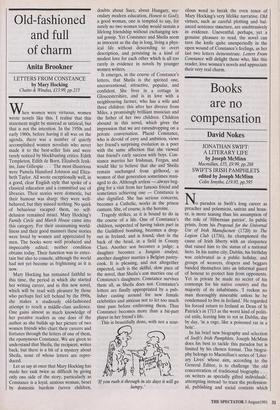Old-fashioned and full of charm
Anita Brookner
LETTERS FROM CONSTANCE by Mary Hocking Chatto & Windus, .£13.99, pp.215 hen women were virtuous, women wrote novels like this. I realise that this statement might be misread as satirical, but that is not the intention. In the 1950s and early 1960s, before having it all was on the agenda, there was a number of quietly accomplished women novelists who never made it to the best-seller lists and were rarely noticed by blockbusting critics: Edith Templeton, Edith de Born, Elizabeth Jenk- ins, Jane Gillespie . . . The most illustrious were Pamela Hansford Johnson and Eliza- beth Taylor. All wrote exceptionally well, in a good, clear English style that spoke of a classical education and a committed use of libraries. Their stories were domestic, but their humour was sharp: they were well- behaved, but they missed nothing. No quirk of behaviour escaped them, no self- delusion remained intact. Mary Hocking's Family Circle and March House came into this category. For their unassuming world- liness and their good manners these stories were loved by women and appreciated by men. The books were well produced and impeccably edited; neither condition obtains today. Their function was to enter- tain but also to console, although the world had not yet become as frightening as it is now.
Mary Hocking has remained faithful to this time, the period in which she started her writing career, and in this new novel, which will be read with pleasure by those who perhaps feel left behind by the 1990s, she makes a studiously old-fashioned attempt to reach a middle-class audience. One gains almost as much knowledge of her putative readers as one does of the author as she builds up her picture of two women friends who chart their careers and fortunes through the letters of one of them, the eponymous Constance. We are given to understand that Sheila, the recipient, writes back, but there is a bit of a mystery about Sheila, none of whose letters are repro- duced.
Let us say at once that Mary Hocking has made her task twice as difficult by giving only one side of the story, particularly as Constance is a loyal, anxious woman, beset by domestic burdens (seven children,
doubts about Suez, about Hungary, sec- ondary modern education, Honest to God); a good woman, one is tempted to say, for surely no two women today would sustain a lifelong friendship without exchanging sex- ual gossip. Yet Constance and Sheila seem as innocent as the day is long, living a phys- ical life without descending to overt description, and persisting in a kind of modest love for each other which is all too rarely in evidence in novels by younger women writers.
It emerges, in the course of Constance's letters, that Sheila is the spirited one, unconventional, attractive, popular, and confident. She lives in a cottage in Gloucestershire, and is in love with a neighbouring farmer, who has a wife and three children: this after her divorce from Miles, a promisingly brilliant musician and the father of her two children. Children abound in this novel, which gives the impression that we are eavesdropping on a private conversation. Placid Constance, who is devoid of envy and ambition, views her friend's surprising evolution as a poet with the same affection that she viewed that friend's early success with boys. Con- stance marries her Irishman, Fergus, and would like to believe that she and Sheila remain unchanged from girlhood, as women of that generation sometimes man- aged to do. Although artless — always beg- ging for a visit from her famous friend and sometimes achieving one — Constance is also dignified. She has serious concerns, becomes a Catholic, works in the prison canteen. She, of course, is the heroine.
Tragedy strikes, as it is bound to do in the course of a life. One of Constance's children, suspected of having taken part in the Guildford bombing, becomes a drop- out in Ireland, and is found, shot in the back of the head, in a field in County Clare. Another son becomes a judge; a daughter becomes a Jungian analyst; another daughter marries a Belgian pastry- cook. It is pleasing, and not altogether expected, such is the skilful, slow pace of the novel, that Sheila's son marries one of Constance's daughters. Constance survives them all, as Sheila does not. Constance's letters are finally appropriated by a pub- lisher casting around for new female celebrities and anxious not to let too much time pass before enthroning them. Thus Constance becomes more than a bit-part player in her friend's life. This is beautifully done, with not a scur- `If you rush it through in six days it will go lumpy.' rilous word to break the even tenor of Mary Hocking's very lifelike narrative. Old virtues, such as careful plotting and bal- anced sentence stsucture, are unobtrusively in evidence. Uneventful, perhaps, yet a genuine pleasure to read, the novel can turn the knife quite unexpectedly in the open wound of Constance's feelings, as her last two letters demonstrate. Letters From Constance will delight those who, like this reader, love women's novels and appreciate their very real charm.


















































 Previous page
Previous page